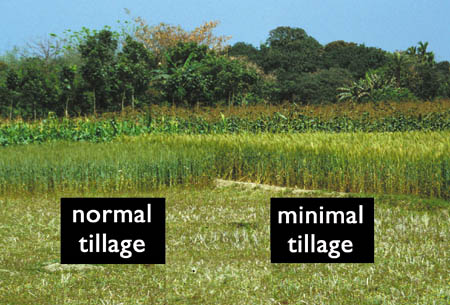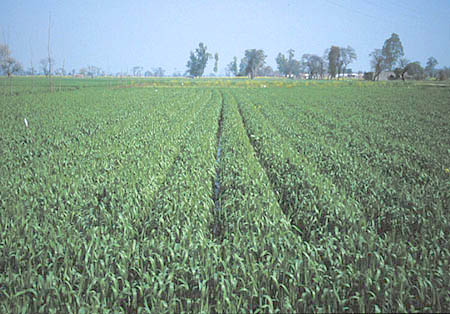Minimum and zero tillage systems are very similar in that the ground is worked very little or not at all before the seed is sown. This approach has increased in use over recent years with, for example, 8 million hectares in Brazil and a major swing towards the technology in Asia.
The most important advantage of minimum tillage is that crops can be sown almost immediately the previous crop has been harvested and commonly approaching the optimum sowing time This is not possible with conventional tillage as that is time consuming. So it is highly suited to areas where two or more crops are rotated on the same land within the year. In much of south Asia yield in wheat reduces rapidly as sowing time is delayed beyond the optimum date for the area (see Hobbs et al., 1997 for details). So delay costs yield. Minimum tillage in addition to shortening turn-around time between crops can be much cheaper than conventional tillage.
Conventional tillage on smallholdings in some parts of Asia can be very exhausting and slow. A common practice in Bangladesh is six ploughings with cattle and 11 plankings, or two passes with a rototiller and four plankings. Only then is the crop sown. Using a minimum till approach the land can be tilled and seeds sown directly in one pass. In that pass, using accessories for example to the Chinese Hand Tractor, a 2” (5 cm) deep seedbed is tilled, the seed is sown and then covered with soil (CA Meisner pers comm.). An even less demanding single pass system is ‘strip till’, which is close to zero tillage, only tilling strips 10 cm wide and 5 cm deep.
Two crops sown after rice in Bangladesh. The 4 passes of normal tillage took 3 weeks, delaying sowing beyond the optimum date. Estimated yield < 2t/ha. The more advanced, minimal tillage crop was sown within 5 days of the rice harvest. Estimated yield 4t/ha.

|
Minimal tillage |
H Gomez Macpherson
Another major advantage of minimum tillage is that land that may be inaccessible for conventional tillage because of wet conditions is usually accessible for direct drilling the wheat crop. For example in eastern UP, Bihar (Northern India) and West Bengal the monsoon rain can extend to October or November when the preceding rice crop is ready to harvest. Consequently, the rice must be removed when the soil is very wet, occasionally with water lying in the fields. Drainage is difficult because the regions are flat. Ploughing and discing prior to planting the wheat is not an option as the soil is too wet and too much time would be lost waiting for drying.
Wheat can be planted on preformed beds of any length, 60-90 cm wide by 15 to 30 cm high, with 2 (or 3) defined planting rows per bed. In some regions such beds are called hills. The channels between the beds supply the irrigation water and drainage, the access for humans for hand operations such as weeding, and the tracks for wheels of machinery for weeding, fertilizer applications and harvesting. The beds are retained over many seasons for successive wheat crops and rotation crops. Machinery wheels do not go on the beds but in the channels. You can find more information in Sayre and Moreno Ramos (1997) and Sayre (2000).
Advantages
Rapid drainage of irrigation water from the bed surface avoids the negative effects of ponding and associated waterlogging (p 68). It avoids deoxygenation of the upper rooting zone for extended periods and allows access to the bed surface for mechanical or hand activities after irrigation.
Pre-sowing irrigation followed by weed removal by cultivation on the beds minimises herbicide use (p 58).
Late irrigations can be applied with less likelihood of lodging (p 49).
Because of easy access by machinery with no compacting of the beds, nitrogen can be applied by banding at first node and later. This leads to much more of the applied nitrogen being used in grain production and much less being lost in irrigation water, through leaching, and as vapour, with associated reduction in environmental pollution.
With precision seeding and a better environment for seedling growth because of fewer competing weeds and better root oxygenation, lower seed densities can be used down to 25 kg ha-1 from the normal 120 kg ha-1 (p 42). This makes hybrids a cheaper proposition.
Because of a better soil environment, seeds can be planted less deep (p 40) resulting in faster seedling emergence and earlier full ground cover and capture of solar radiation (p 44). This is of particular importance in short season crops and in hotter environments.
Crop residues can be left in the furrows for stabilization (p 61). Minimum and zero till systems (p 84) can be used more profitably on beds.
Overall economic efficiency is increased with the bed system because inputs are reduced (herbicides, insecticides, fertilizers, water) without a major penalty in yield.
A most significant benefit in multiple cropping systems such as a rice - wheat rotation is that turn around time between crops is short. Theoretically, wheat can be planted the day after the preceding rice crop is harvested using minimum or zero till on beds.
A crop in India grown on raised beds separated by irrigation/access channels

H Gomez Macpherson
Disadvantages
A high proportion of the land surface is irrigation/drainage/wheel channels and so is not planted. Consequently full field cover by the crop is delayed compared with full surface seeding. This could result in reduced yield of up to 20% particularly in short season crops.
There is a cost involved in initial bed preparation and occasionally in bed maintenance between crops; though special costly machinery is not essential, time and effort is.
All wheat varieties are not suitable for bed production. Some have much lower yields that when used with conventional cultivation.